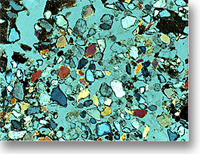April 03, 2007
Groundbreaking:

Extreme Landscapes in Grains and Pixels
This paper reflects on Groundbreaking: Extreme Landscapes in Grains and Pixels, a real-time generative installation commissioned from the authors by the UK Research Councils. The work interrogates visual and sonic representations of soil studies to reveal interaction and tension between extreme environments and cultural experience, between scientific understanding and contemporary soundart practice. The work offers a critique of scientific hierarchies; its assertions, assumptions and attendant aphorisms. Challenges to established hierarchies are embedded in science's history - Francis Bacon's Novum Organum still questions today's domains - and continue to resonate within debates about risk in science's future directions. Such a resonance is re-evaluated in processes of deduction, to link scientific assertion with societal comment, and abstraction, to link scientific modes of representation with artistic values of communication, visualisation and sonification .
People who live in geographically and socially marginalised areas, vulnerable to climate change, provide compelling impetus for this investigation. The Sahel is one such area, contrasting the desertified extremes of the Sahara with the needs of nomadic pastoralists and of settled agrarian peoples.
There are established deductive understandings of interaction between the environment and society at a regional- and local-scale; how people use (and used) the landscape to support their daily lives, how landscapes are managed to achieve this and influence the development of society. Repeated snapshots of the Sahel region offer one understanding, at least within subject domains entrained in sequences of similar studies: they suggest how adaptive strategies can be developed for the future of this region. Instead, we can break out of this entrenchment, investigate new forms of dialogue that examine atypical physical scales of human-landscape interaction. Evidence of human activity may be preserved in the sediment of an extreme landscape, and by examining these we gain an understanding of the nature and intensity of past human-landscape interactions in an extreme context, and a trajectory for the future.
This paper aims to further the comprehension of such interactions, reaching across barriers presented by different temporal and spatial scales: between landscape and the production of artefacts, between the scientific analysis of artefacts and their manufacture, between the perception of visual and sonified representations, and between micro-scale information and macro-scale evidence of extreme climatic change. In doing so, and with reference to the authors' installation work, novel understandings are elicited regarding the nature, scale and quality of the interfaces present.
National Museum of Scotland, Edinburgh 2007. Supported by Research Councils UK, NSW2007 Award.
Blackwell, T. and Young, M. (2004) Self-Organised Music. Organised Sound 9:2, 123-36
Adderley, W.P., et al (2004) Enhancing ethno-pedology: integrated approaches to Kanuri and Shuwa Arab definitions in the Kala-Balge region. Catena 58, 41-64.
Adderley, W.P., Simpson, I.A. and Davidson, D.A. (2006) Historic landscape management: a validation of quantitative soil thin section analyses. Journal of Archaeological Science 33, 320-334.
Paul Adderley is a soil scientist with interests in geoarchaeology and environmental history. An RCUK Academic Fellow at the University of Stirling, Scotland, he specialises in the sustainability of societies in extreme environments such as Greenland and the African Sahel; he lectures on topics surrounding environmental risk. Recent studies have centred on understandings of long-term societal-climatic interactions.
Michael Young is a composer with interests in computer music and interactive media. He lectures at Goldsmiths, University of London and cofounded the Live Algorithms for Music network www.livealgorithms.org. Recent compositions include Aur(or)a, a generative system for solo instrument and computer (2006) and Argrophylax (2005) for oboe and electronics.
Paul Adderley and Michael Young will speak a the MUTAMORPHOSIS conference, Nov 7-10 2007.
Posted by jo at April 3, 2007 07:33 PM
